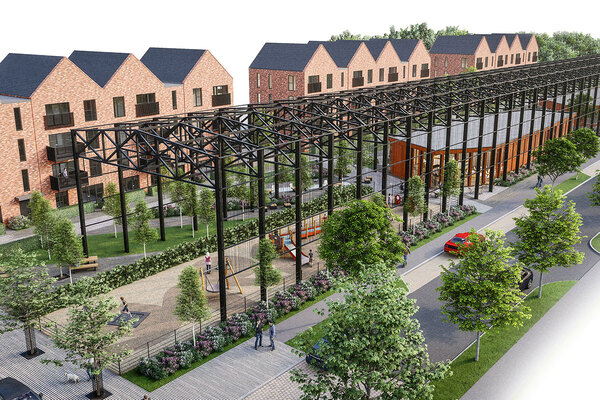You are viewing 1 of your 1 free articles
How low-scoring councils are responding to the Housing Delivery Test
One Hampshire council is building half as many homes as it needs, while another is building more than double. Nathaniel Barker finds out what the Housing Delivery Test can tell us. Illustration by Fran Labuschagne
Hampshire is an interesting place for planning policy enthusiasts. In the county’s north-east corner, the district of Hart is considered to be delivering a whopping 241% of housing needed in the area – that is nearly two-and-a-half times more homes being built than required. On the other side of the shire, New Forest is delivering just 41%.
That is all thanks to the quirks of the government’s Housing Delivery Test (HDT), which seeks to measure how well planning authorities (usually councils) are performing when it comes to ensuring enough homes are built in their jurisdictions. The 2019 test – only the second ever – was published last month, with eight councils penalised for their low scores. All are in the South East, London or the East of England.
Here, Inside Housing explores what is going wrong for some of those authorities and how they hope to step up delivery.
To calculate each authority’s HDT score, the net number of homes built in the area over the previous three years is expressed as a percentage of the number of homes deemed to be required in the area over the same period. If that figure is above 95%, the test is passed.
But scores below 95% trigger certain consequences. For the 2019 measurement, authorities deemed to be delivering between 85% and 95% of housing needed must put together an action plan setting out how they will boost development. Authorities which score below 85% must also identify a 20% land ‘buffer’ – meaning 20% more land for development than is currently allocated in their five-year pipeline.
“For local authorities that already have an adopted local plan in place, that is something they would want to avoid”
Below 45%, the toughest penalty kicks in: ‘the presumption in favour of sustainable development’. Effectively, this means councils are forced to give greater weight to the government’s National Planning Policy Framework (NPPF) relative to their local policies when deciding whether to accept planning applications.
What does that mean in practice? “It’s not binary; both these things matter but the balance changes,” explains Matthew Spry, a senior director at planning consultancy Lichfields.
For example, the fact that a site is not allocated as part of a local plan must become less important to councillors considering whether to grant planning permission than the key NPPF test of whether the benefits of development are not outweighed by potential harmful impacts. The presumption may also make it harder for authorities to enforce specific planning policies – such as tenure mixes of affordable housing.
“For local authorities that already have an adopted local plan in place, that is something they would want to avoid,” adds Mr Spry. “They have put a lot of time and work putting that together and the presumption in favour would mean those policies they have prepared carry less weight.”
“[Eastbourne’s score is] a direct result of limited land availability within a constrained seaside town”
For now, seven of the eight authorities falling below the 45% mark (see table, below) are already subject to the “presumption” because they have not adopted new local plans since the 2012 NPPF was published – with the City of London the exception. However, when next year’s measurement is taken, the threshold will be much tougher: rising from 45% to 75%. Many more authorities will likely be caught, including more areas which do have up-to-date local plans and so are hit for the first time.
The complex part of calculating the test scores is working out how many homes are required in each area. Where authorities have an up-to-date local plan in place, this forms the basis for the figure.
But for areas without a recent plan, the government uses a national formula. In the 2018 measurement, this calculation was based entirely on household growth projections, although the more stretching ‘objectively assessed housing need’ (OAN) is being phased in from 2018/19 onwards. By 2021, authorities without an up-to-date local plan will be assessed entirely against the need figures.
This method can lead to very low HDT scores for some authorities and very high ones for others. All eight councils falling below 45% for 2019 have huge need targets set by the standardised OAN.
“There’s definitely a correlation between poor HDT scores and no local plan”
The housing requirement figures are partly based on historical levels of growth. Therefore, areas that have had little housing development in the past end up with an artificially low need figure. Hart, which does not have an up-to-date local plan, is a good example of this: despite being an area of high demand with significant affordability pressures, the 2019 test only deemed it to need 741 homes.
At the same time, a recent glut of building helped by office-to-residential conversions in Hart’s main town of Fleet carried out through permitted development rights has seen it deliver 1,787 homes in the same period – resulting in a HDT score of 241% for 2019.
“In reality, if you were to benchmark completions against the housing requirement in the local plan to be adopted later this month, it’s closer to 140%,” explains Daniel Hawes, planning policy manager at Hart Council. The authority predicts that by 2026 it will start to lag behind the magic 95% per the 420 homes a year target set by its plan, as a few large sites complete – but in the full local plan period up to 2032, need will be met.
Additionally, unlike local plans, the nationally calculated need figures take no account of specific local conditions. Leigh Palmer, interim head of planning at Eastbourne Council, says the authority’s HDT score of 38% is “a direct result of limited land availability within a constrained seaside town”.
Housing Delivery Test scores for authorities falling below the ‘presumption’ threshold
| Homes required | Homes delivered | ||||||||
| Local authority | 2016/17 | 2017/18 | 2018/19 | Total | 2016/17 | 2017/18 | 2018/19 | Total | Score |
| Basildon | 657 | 773 | 1,076 | 2506 | 412 | 341 | 340 | 1,093 | 44% |
| City of London | 94 | 71 | 110 | 275 | 7 | 26 | 55 | 88 | 32% |
| Eastbourne | 239 | 269 | 691 | 1,199 | 203 | 127 | 130 | 460 | 38% |
| Havering | 1,170 | 1,170 | 1,170 | 3,510 | 436 | 265 | 465 | 1,167 | 33% |
| New Forest | 726 | 700 | 989 | 2,415 | 359 | 292 | 387 | 1,038 | 43% |
| North Hertfordshire | 699 | 709 | 988 | 2,395 | 539 | 281 | 222 | 1,042 | 44% |
| Thanet | 709 | 793 | 1,114 | 2,616 | 389 | 238 | 296 | 923 | 35% |
With the South Downs National Park in the west, the English Channel to the south and a large floodplain in the middle, the borough certainly has more physical barriers to development than most areas.
Other authorities with scores below 45% may have similar complaints: New Forest has the National Park, Thanet is also coastal, and Basildon contains a large chunk of green belt.
“For delivery targets to be achieved we need national house builders to be more enthusiastic and proactive about building in Thanet”
Unsurprisingly, top of the list for these councils is getting a local plan in place which identifies enough land to meet their area’s housing need. “There’s definitely a correlation between poor HDT scores and no local plan,” remarks Mr Spry.
“It’s a very important vehicle for delivering housing policy by allocating land. But also, for the test, it’s the mechanism for councils with natural constraints to set housing requirements below housing need, and that then becomes the benchmark for housing delivery.”
Basildon is awaiting Planning Inspectorate approval for its new local plan following a year-long delay imposed by the Department for Environment, Food and Rural Affairs over concerns about pollution levels on an arterial road in the borough.
Council leader Gavin Callaghan suggests the authority has been holding off on big planning decisions until the document is in place – which may have impacted its HDT scores. “I know that when that local plan is adopted we can get homes delivered across the borough,” he adds confidently.
Later this month the council is also expected to approve a masterplan for Basildon town centre, which Mr Callaghan says aims to “significantly increase density” there, delivering “the best part of 1,000 homes”.
Thanet also hopes its own plan will be adopted “in the next few months”, says council leader Rick Everitt. New Forest’s new local plan – expected to be adopted in May – will slash its requirement figures in half for the first three years.
“Our local plan requirement is for 30% of new homes to be affordable, but developers will clearly look to chip away at that”
Then there are direct intervention measures. As stock-retaining councils, Thanet, Eastbourne and Basildon are all taking steps to build more homes themselves. The former two are setting up housing companies, and Basildon already has one. Mr Palmer adds that Eastbourne is working with Homes England on “a number of initiatives around forging public sector partnerships over land assembly”.
Authorities are also looking at tweaking their policies and systems in a bid to speed up the planning process, Mr Spry says. That may involve setting clear targets and guidance on how much affordable housing is expected. “It’s about having a level where there is confidence that developers can deliver across the board,” he explains.
None of the councils Inside Housing speaks to are reducing affordable housing requirements yet, although there are concerns about how low HDT scores could affect their negotiating position when disputes over viability arise.
“I think it’s hugely undermining,” says Mr Callaghan. “Our local plan requirement is for 30% of new homes to be affordable, but developers will clearly look to chip away at that.”
While these efforts will doubtless make a difference to housing delivery, some uncertainty remains for councils over whether meeting 95% of local need is achievable. For Eastbourne, Mr Palmer says, the HDT target “can only be aspirational”.
Part of that stems from a sense among them that they are not fully masters of their own housing destinies. Planning, Mr Everitt of Thanet Council contends, “is only part of the story”.
“For delivery targets to be achieved we need national house builders to be more enthusiastic and proactive about building in Thanet,” he adds, pointing to the fact that there are 3,570 homes in the borough with planning consent but no building work started.
Mr Palmer notes that Eastbourne Council’s planning application approval rate is over 95%, but says the schemes coming forward “are not of the size and scale required”.
Again, Mr Spry argues that updating local plans should be the first step here. “For house builders, doing speculative applications in areas without an up-to-date local plan can be a risky business,” he says. “And less track record of delivery in an area is also going to be a deterrent.”
At the same time, both Mr Everitt and Mr Callaghan feel their councils are somewhat at the mercy of decisions made by county councils, particularly when it comes to the status of large infrastructure projects to support new homes.
Clearly, none of these levers are quick wins and will take time to deliver results. The real test for the HDT itself will come some years down the line, once the anomalies have smoothed out and it becomes clear whether low-scoring authorities are managing to increase delivery.
Sign up for our Council Focus newsletter
Already have an account? Click here to manage your newsletters












